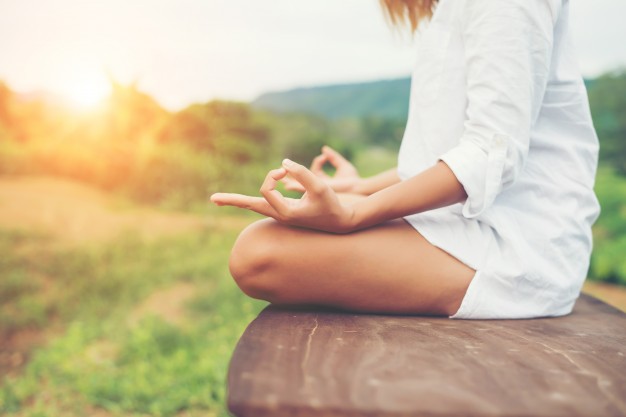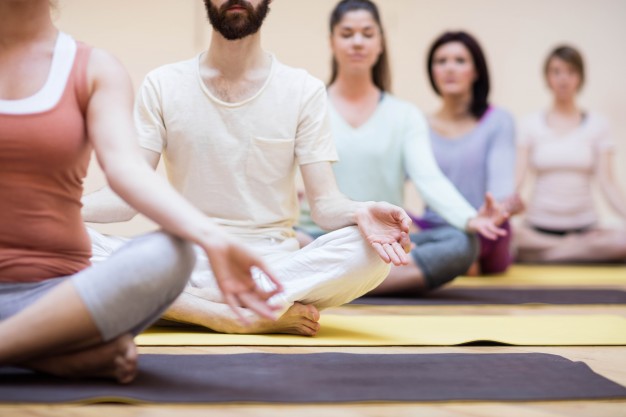MEDITATION

What is Meditation?
An exquisite methodology exists within the yoga tradition that is designed to reveal the interconnectedness of every living thing. This fundamental unity is referred to as advaita. Meditation is the actual experience of this union.
By dictionary definition, "meditation" means to reflect upon, ponder, or contemplate. It can also denote a devotional exercise of contemplation or a contemplative discourse of a religious or philosophical nature. The word meditate comes from the Latin meditari, which means to think about or consider. Med is the root of this word and means "to take appropriate measures."
In the yogic context, meditation, or dhyana, is defined more specifically as a state of pure consciousness. It is the seventh stage, or limb, of the yogic path and follows dharana, the art of concentration. Dhyana in turn precedes samadhi, the state of final liberation or enlightenment, the last step in Patanjali's eight-limbed system. These three limbs—dharana (concentration), dhyana (meditation), and samadhi (ecstasy)—are inextricably linked and collectively referred to as samyama, the inner practice, or subtle discipline, of the yogic path.
Recall that the first four limbs—yama (ethics), niyama (self-discipline), asana(posture), and Pranayama (life-force extension)—are considered external disciplines. The fifth step, pratyahara represents the withdrawal of the senses. This sensual withdrawal arises out of the practice of the first four steps and links the external to the internal. When we are grounded physically and mentally, we are keenly aware of our senses, yet disengaged at the same time. Without this ability to remain detached yet observant, it is not possible to meditate. Even though you need to be able to concentrate in order to meditate, meditation is more than concentration. It ultimately evolves into an expanded state of awareness.

When we concentrate, we direct our mind toward what appears to be an object apart from ourselves. We become acquainted with this object and establish contact with it. To shift into the meditation realm, however, we need to become involved with this object; we need to communicate with it. The result of this exchange, of course, is a deep awareness that there is no difference between us (as the subject) and that which we concentrate or meditate upon (the object). This brings us to the state of samadhi, or self-realization.
How to Meditate?
5 simple steps to start meditation:
1. Where? Any part of your home works as long it is quiet and there is no hustle-bustle around. Make sure the place you pick is also well-ventilated. If required use earplugs to stop external disturbing noises.
2. When? Mornings are suggested by most experts simply because meditation allows you to start off your day on a good note. Having said that, meditation can be done anytime of the day! Don’t go by what others tell you – if middle of the day works for you then go for it. Find a routine that works for you but be regular. A few minutes every day will go a long way in your efforts to master this art.
3. Don’t meditate on a heavy stomach. You don’t want to put yourself to sleep or feel drowsy. At the same time, avoid doing it just before meal-times. The idea is to find a spot in your daily schedule when you are relaxed and not distracted.
4. Close your eyes. Try to ‘collect’ your thoughts and put them away for a little while. Consciously tell yourself that for this short period of time you will not think about anything else. Take a few minutes and normalise breathing and don’t rush into things.
5. Start by focusing on your breath. Breathe normally for a few times. If it helps count the number of breaths you take, to begin with. Mediation starts first by controlling your mind to ‘concentrate’ on one thing and not wander off. As you learn to control your thoughts you will find it easier to get into in a ‘thoughtless’ state, and then to stay there longer. Each time your thoughts run away to another topic, you must ‘come back’ to focusing on your breath.

The Benefits of Meditation
Research has confirmed what the yogis of ancient times already knew: Profound physiological and psychological changes take place when we meditate, causing an actual shift in the brain and in the involuntary processes of the body.
The health benefits meditation produces naturally reflect the mental and physical effects of this process. At the very least, meditation teaches you how to manage stress; reducing stress in turn enhances your overall physical health and emotional well-being. On a deeper level, it can add to the quality of your life by teaching you to be fully alert, aware, and alive. In short, it is a celebration of your-self. You are not meditating to get anything, but rather to look at and let go of anything you do not need.
When and Where to Practice
To establish consistency, meditate at the same time and in the same place every day. Choose a place that is quiet, one that is pleasant, where you'll be undisturbed. Traditionally, the morning is considered the optimal time because you are less likely to be distracted by the demands of your day. Many people find that a morning meditation helps them enter the day with a greater degree of equanimity and poise. However, if a morning practice is a struggle, try an afternoon or early evening meditation. Some may find it difficult to concentrate and meditate due to external disturbances due noises of traffic, people and work in such cases one can use ear plugs to block external noises and meditate peacefully.
If you are new to yoga and meditation, you may find adding 5 or 10 minutes of meditation at the end of your asana practice enough. When meditating independently of your yoga practice, a 15- to 20-minute time frame seems manageable for most beginners.
